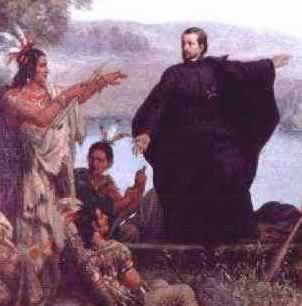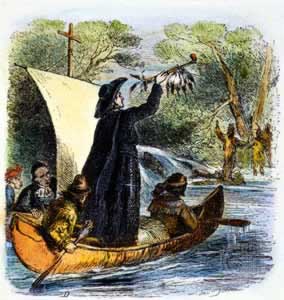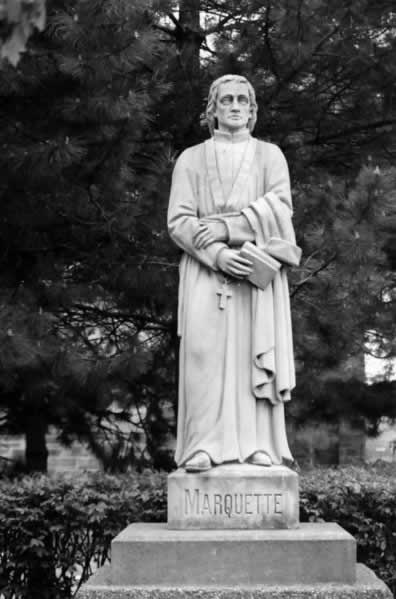Think that you may own a portrait of Jacques Marquette? We identify, appraise and issue Certificates of Authenticity (COA) for all portraits of Jacques Marquette.

Portrait of Marquette, Artist Unknown
Father Jacques Marquette and Louis Jolliet were the first Europeans to see and map the northern portion of the Mississippi River. Father Marquette was born in Laon, France, and joined the Society of Jesus at age seventeen. After working and teaching in France for several years, he was dispatched to Quebec in 1666 to preach to the Native Americans, where he showed great proficiency in the local languages, especially Huron.

Father Marquette Preaching
In 1668 Father Marquette was redeployed by his superiors to missions farther up the St. Lawrence River in the western Great Lakes. He worked at Sault Ste. Marie and at the Mission of the Holy Spirit in La Pointe, on Lake Superior, near the present-day city of Ashland, Wisconsin. Here, he came into contact with members of the Illinois tribes, who told him of the existence of the Mississippi River and invited him to come teach further south. Due to wars between the Hurons at La Pointe and the neighboring Dakota people, however, Father Marquette had to relocate to the Straits of Mackinac; he informed his superiors about the rumored river, and requested permission to explore it.
Leave was granted, and in 1673, Marquette was joined by Louis Joliet, a French Canadian explorer. They departed from St. Ignace on May 17, with two canoes and five other voyageurs of French-Indian ancestry. They followed Lake Michigan to the Bay of Green Bay and up the Fox River. From here, they portaged to the Wisconsin River, which they were told led to the river they sought. On June 17, they entered the Mississippi near Prairie du Chien, becoming the first Europeans to enter the river.

Marquette, US 1 Cent Stamp
The Joliet-Marquette expedition traveled to within 435 miles (700 km) away from the Gulf of Mexico, but turned back at the mouth of the Arkansas River. By this point they had encountered a number of natives carrying European trinkets, and they feared an encounter with explorers or colonists from Spain. They followed the Mississippi back to the mouth of the Illinois River, which they learned from local natives was a shorter route back to the Great Lakes. They returned to Lake Michigan at the point of modern-day Chicago. Marquette stopped at the mission of St. Francis Xavier in Green Bay in September, while Joliet returned to Quebec to relate the good news of their discoveries.

Marquette drawing, Marquette University Archives
Marquette and his party returned to the Illinois Territory in late 1674, becoming the first Europeans to winter in what would become the city of Chicago. In the spring of 1675, the missionary again paddled westward, and celebrated a public Mass at the Grand Village of the Illinois near Starved Rock. A bout of dysentery picked up during the Mississippi expedition, however, had sapped his health. On the return trip to St. Ignace, he died near the modern town of Ludington, Michigan, although the precise date and location are unknown.

Father Jacques Marquette and Louis Jolliet on the Mississippi River, 1673
Father Marquette is memorialized in several towns and rivers that bear his name (such as Marquette, Michigan), as well as the Father Marquette National Memorial near St. Ignace, Michigan. There are also a number of portraits made of this explorer and national figure, so it is suffice to say that many more will surface some day.

Statue of Marquette, Detroit, Michigan
Still wondering about a portrait in your family collection? Contact us... it could be a portrait of Jacques Marquette.
